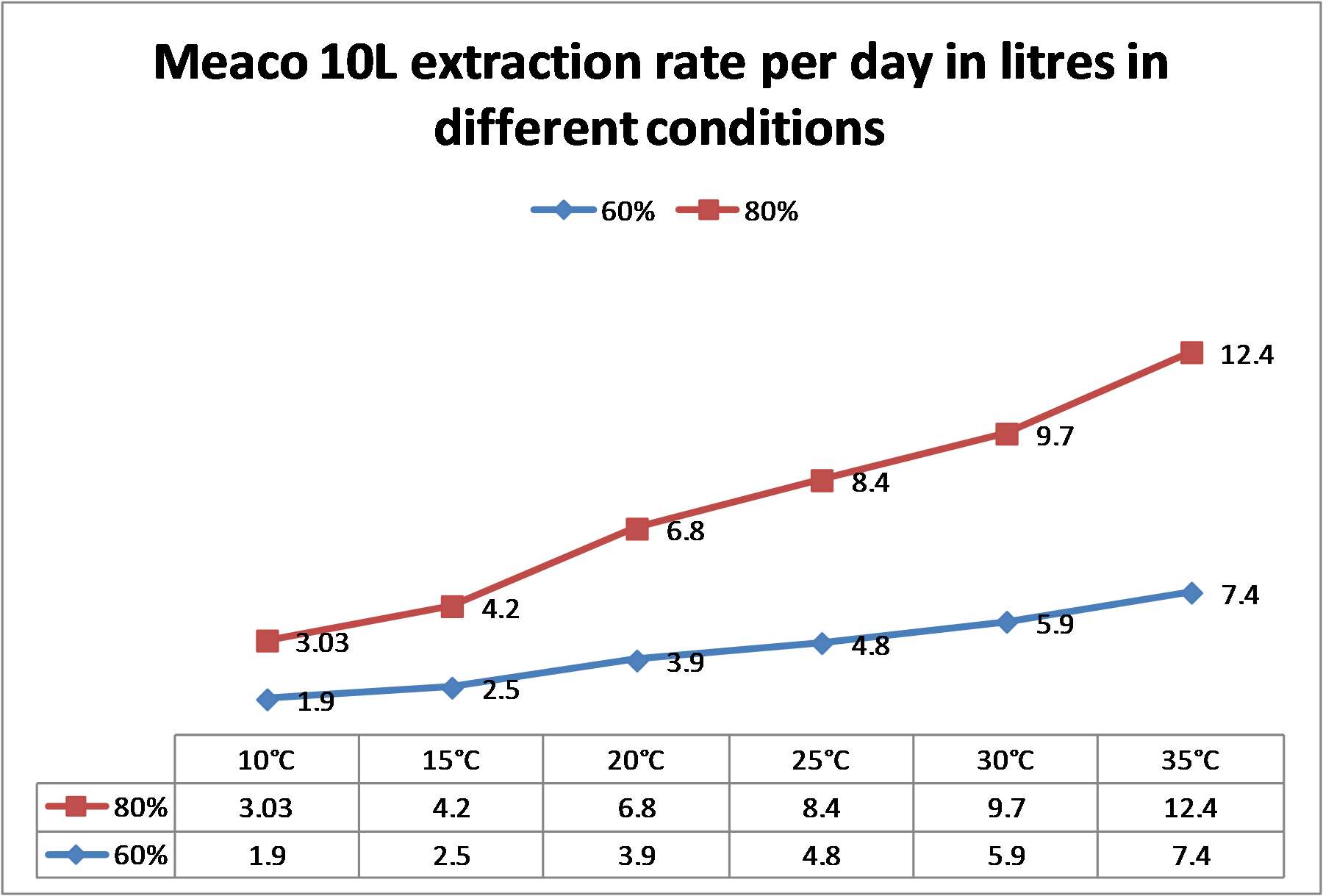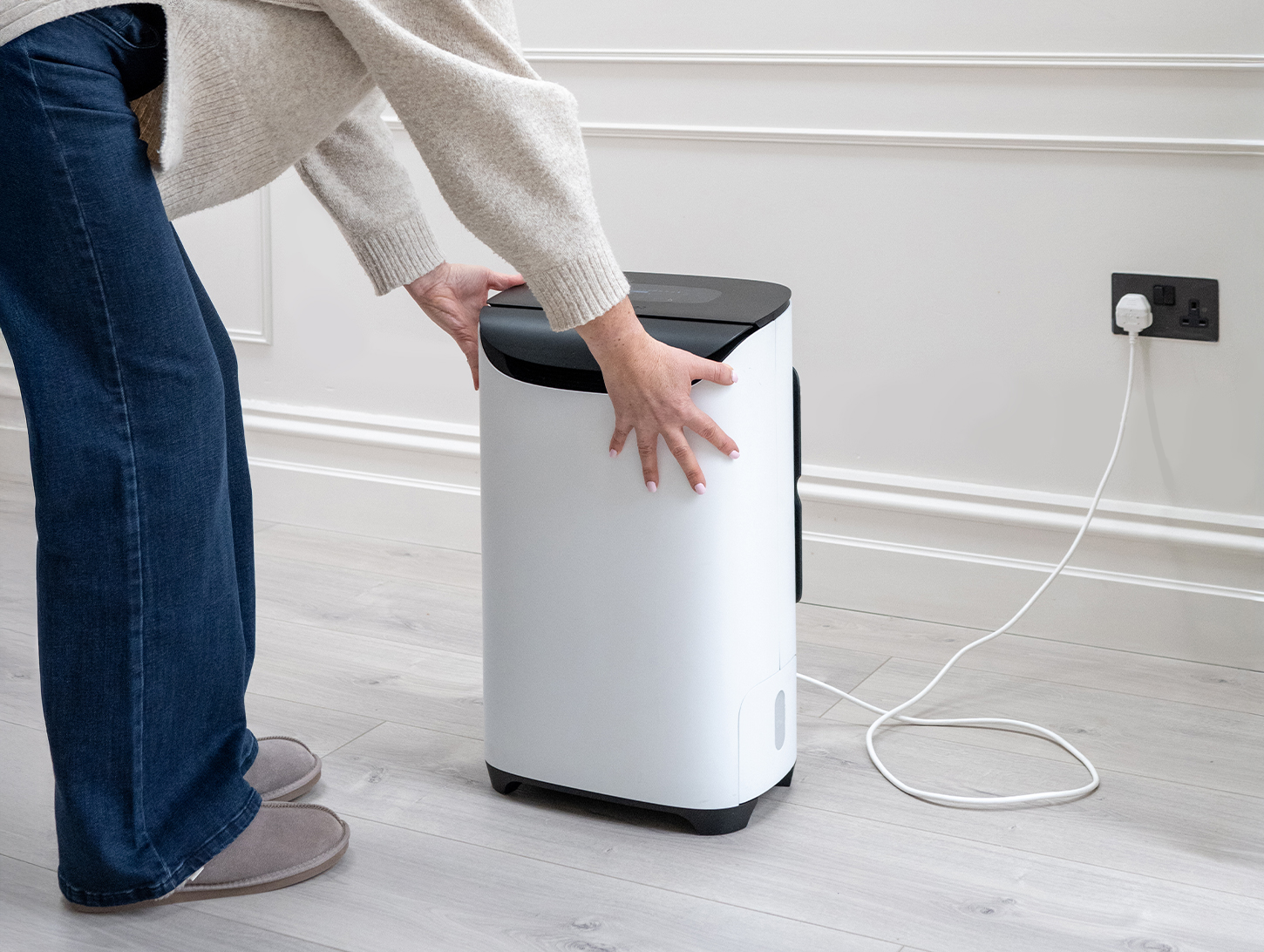Buyers are often confused about the way we label dehumidifiers. Extraction rate, the size of the water tank and other measurements mean that it can be tricky to understand exactly how you can compare one dehumidifier to another.
Dehumidifier extraction rate – an explanation
It all comes down to how the capacity of a dehumidifier is calculated. For example, on the Meaco website we use 30°C and 80%rh as the benchmark for all of our dehumidifiers. This allows our customers to clearly see which dehumidifier is smallest, which is largest and so on.
It’s always good to have single figures for comparison, but if we don’t regularly have temperatures of 30°C and 80%rh in the UK then why do we use those figures for comparison?
It’s a good question.
The humidity levels in the biggest dehumidifier markets
It all comes back to the fact that the largest markets in the world for dehumidifiers are all in tropical areas: Hong Kong, China, Japan, South Korea and so on. In these countries, hot and humid conditions are more common and you can see how 30°C and 80%rh has evolved as a common standard.
Ideally, we would like European resellers to agree on 20°C and 60%rh as a common standard for comparison but take a quick look around the various brands websites and you will see that many use 32°C and 90 or 95%rh in order to boost their extraction rates. We’re still lobbying for standards that are more relatable to the common temperatures and humidity levels that you see in Europe, but for now, our products use the main standard, which makes them easier to compare with other models.
So, why is the dehumidifer extraction rate higher than the tank capacity?
But back to the original point as to why the buckets are smaller than the extraction rate and how often you might have to empty the container.

Firstly, if you had a 10 or 20 litre container capacity, the dehumidifier would have to be huge. And, as one litre of water is equal to one kilo, it would be hard to lift and empty a full container. These, therefore, are the reasons why the container is smaller.
A compressor dehumidifier’s extraction rate will lessen as the temperature and relative humidity falls. This is just a matter of physics and is something that is common in all models from all manufacturers. So in a real world situation in Europe you would be looking at room conditions closer to the 20°C and 60%rh that we mentioned above.
Comparison Graphs – Extraction Rates (Meaco 20L & 10L) in different conditions.
Below is a graph showing the extraction rate for the Meaco 20L in different conditions. You can clearly see how its extraction rate falls as the conditions cool. The Meaco 20L is a very popular and very effective dehumidifier and the one that we use ourselves at home. As you can see the graph predicts around 8 litres a day in average conditions and that matches our own experiences.

For the Meaco 10L the graph shows the same trend and once again it offers a very efficient performance at room temperatures. This will be why the Meaco 10L is getting such good reviews.

If you have any questions on extraction rates and dehumidifiers then please feel free to leave a comment below or contact us via sales@meaco.com or call the office on 01483 234900 and we will be delighted to assist.
Products featured: Meaco 20L







10 responses
I purchased the 12L Arete Two dehumidifier 3 days ago, for a room with high humidity of 73%.
I ran the unit constantly on laundry mode for the first 24hrs in this small room with window and door shut at a constant temperature of 20.5C… the humidity came down to 65% (verified by having an Awair Air Monitor checking temp & humidity all the time… my monitor and dehumidifier both showing same values of humidity throughout).
However the dehumidifier only collected 2L of water in that first 24hrs.
Your published figures on the 10L Arete One running at 20C 60% humidity states a value of 3.9L water collection in 24hr. Why I’m I only getting half this figure in a room with slightly higher temperature and humidity?
Ian,
Thank you for your question. The difference in water collection you’re seeing could be due to a few factors. First, the published figures for water collection rates are based on specific test conditions, and actual performance can vary depending on several factors, including the size of the room, air circulation, and the overall humidity level. The humidity might fluctuate in certain areas of the room, or there could be other environmental factors at play, like air leakage or ventilation, that may affect how much water is being extracted.
However, the important thing to note is that you are seeing a clear difference in the humidity levels, and water is being collected, which indicates that the unit is working as intended.
Let me know if you need further clarification or assistance, otherwise, I hope this helps!
Omar@Meaco.
I would imagine that the collection rate reduces as the dehumidifier does its job and humidity falls (less water is being collected at 70%, say, than at 80%), even though the temperature is remaining the same. It would only collect that stated figure if the humidity didn’t fall, surely?
Paul,
Thank you for your enquiry. Yes that’s correct. The published collection rates assume a constant high humidity under controlled test conditions. In real use, as the dehumidifier lowers the humidity in the room, there’s simply less moisture in the air to extract, so the collection rate naturally drops. Even if the temperature stays the same, the unit will collect less water once the humidity falls from, say, 80% to 65–70%.
Thank you for your input!
Omar@Meaco
How many litres will the Meaco 40L extract per day at 25c 60% rh
Thank you
John,
I don’t have an exact answer for you but this page here will probably help – http://www.meaco.com/blog/2012/03/06/my-dehumidifier-is-bigger-than-your-dehumidifier-no-its-not/. I would say that 18 tp 20 litres a day would be a good estimate.
Hope this helps.
regards
Chris
I am interested in your commercial dehumidifiers and would like some advice.
The meaco 40l has an extraction rate of 40l per day at 30c & 80% rh with an airflow of 180 cubic metres an hour.
The nader midi 03 has an extraction rate of 21.5l per day at 30c & 80% rh with an airflow of 300 cubic metres an hour.
How is the meaco 40L able to remove almost twice the moisture per day as the nader midi 03 when the airflow is 40% less?
Why is the meaco unit half the price of the nader midi?
I have a damp problem and will soon be renovating our old property. At present I am using another brand dehumidifier (x2) and still battling damp and mold.
My current dehumidifier is rated at 18l per day at 32c 90% rh & 10l per day @ 30c 80% rh.
These units whilst collecting water daily are not coping with the damp and humidity in the house and our hygrometer is reading at 68-70%, and we have had mold on walls.
With the above in mind I am concerned about making the correct purchase & I would be grateful if you could advise on your commercial units and how efficient they are at dealing with a damp problem that other brand domestic units aren’t coping with.
Tohn,
Thanks for your message.
The 40L has a large compressor and condensor than the Midi 03, hence the larger extraction rate per day. the reason why the Midi 03 has a larger fan is that it is most commonly used to dry out areas where the fabric of the room is actually wet and a faster airflow will help to dry the space more quickly (similar to drying washing faster on a clothes line on a windy day).
The Midi 03 is a metal dehumidifier made in Europe while the Meaco 40l is a plastic dehumidifier made in China. The cost of the metal and the European labour rates make up the bulk of the price difference.
With regards to your project if you could tell me how large the house is, whether it is heated, whether the fabric of the space needs to be dried (ie fresh plaster on the walls?) and whether we are talking about drying individual rooms or the whole house and then I would be delighted to try and point you in the right direction.
regards
Chris
I have 4 hygrometers that all say my house has a humidity of 80%rh
the temperature is varies between 19 and 21 deg c
My meacco dd8l only extracts 2 litres of water in 24 hours
I have mold present in the bathroom etc
Meacco customer services keep telling me there is nothing wrong with it
The information above seems to contradict that so why are meacco so reluctant to do anything about my dehumidier
keith,
Thank you for your comment, this is something that comes up on a regular basis and I have written a full reply here that is worth a read – http://www.meaco.com/blog/?p=685.
Where we have looked at this before about 9 times out of 10 it has turned out that the dehumidifier is fine. What we usually do if required is to calibrate the thermohygrometer because that is easier than collecting the dehumidifier. My first suggestion would be to get the DD8L working harder for you and to use the second fan speed continuously and look at your sources of moisture and use the dehumidifier around those points (cooking, bathing etc). If n3ecessary use the Laundry mode more around these events.
With regard to the thermohygrometers there is a lot of information in the article but where are they in relationship to the dehumidifier, how old are they, how fast do they react and where is the dehumidifier in relationship to the thermohygrometers and how long has it been on for?
There is another possibility which is that both the dehumidifiers and the thermohygrometers are right, but that is a bit more of a complicated answer which I will save for later if required.
regards
Chris